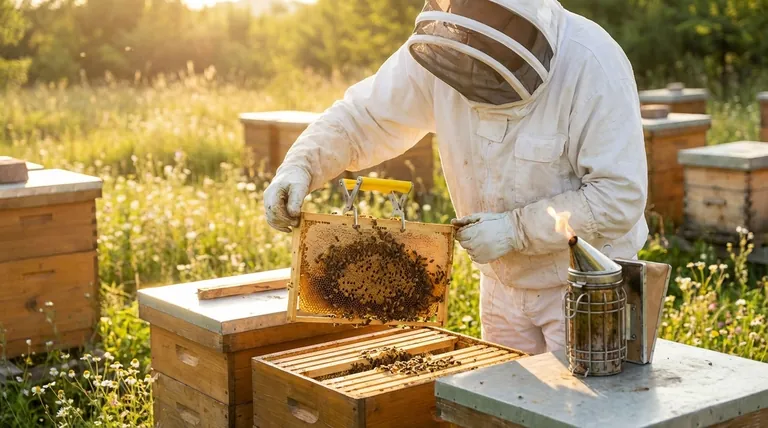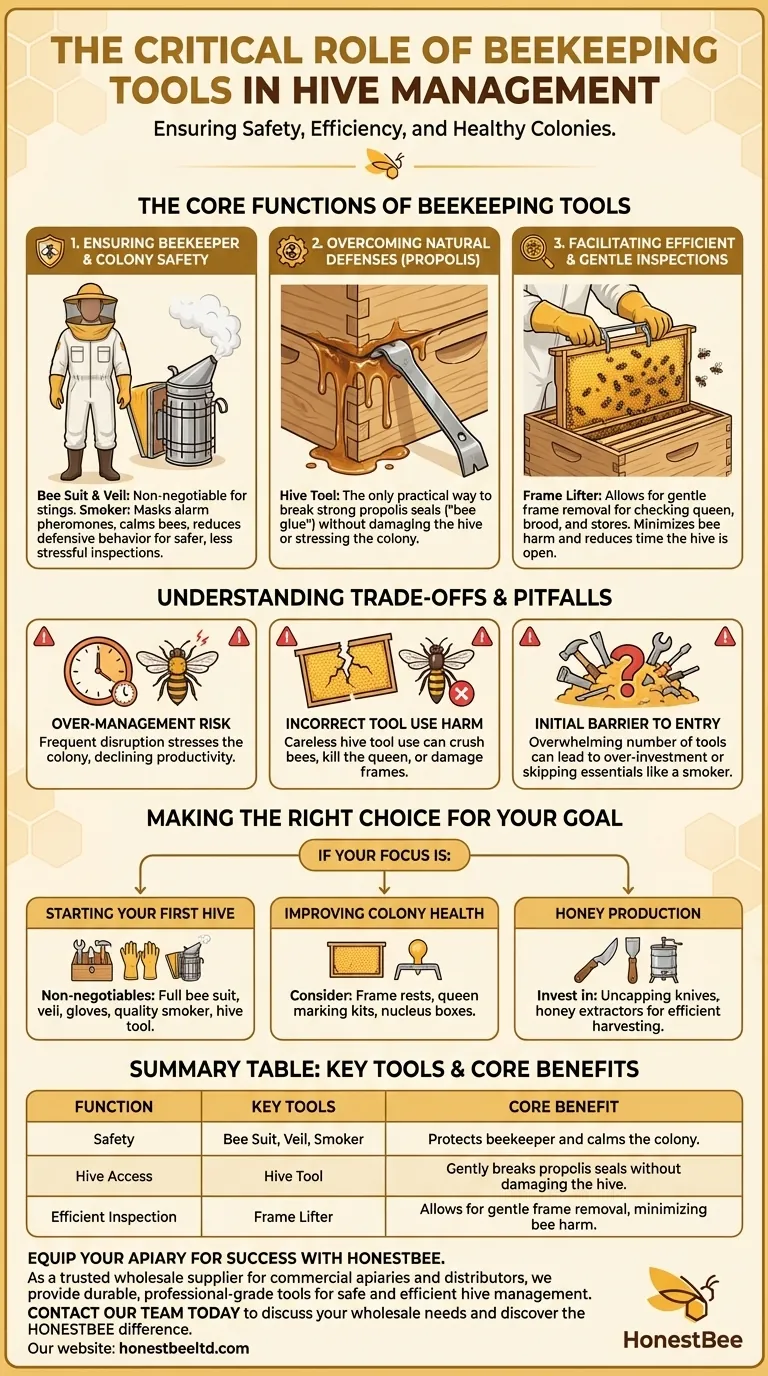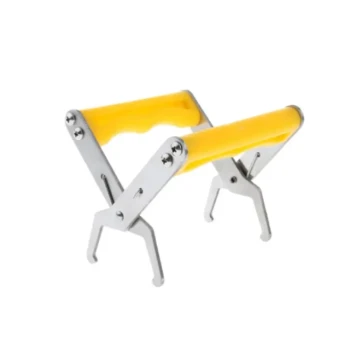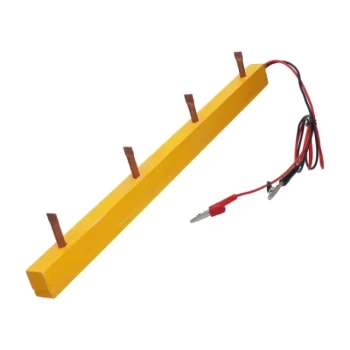At their most fundamental level, beekeeping tools are the essential interface between the beekeeper and the honey bee colony. They are not merely for convenience; they are critical for ensuring the safety of the beekeeper, minimizing stress on the bees, and enabling the precise management tasks necessary for a healthy and productive hive. Without these tools, effective beekeeping would be nearly impossible.
The true importance of beekeeping tools lies in their ability to solve the biological challenges presented by the bees themselves. They allow a beekeeper to work with the colony's natural defenses and construction habits, rather than fighting against them, making careful and non-invasive management achievable.

The Core Functions of Beekeeping Tools
To understand their importance, we must look at the specific problems each tool is designed to solve. These functions fall into three main categories: safety, efficiency, and overcoming the hive's natural structure.
Ensuring Beekeeper and Colony Safety
The most obvious function of tools like a bee suit, veil, and gloves is protecting the beekeeper from stings. This is non-negotiable for safe hive inspections.
Equally important is the smoker. Smoke masks the bees' alarm pheromones, calming the colony and reducing defensive behavior. This makes inspections safer for the beekeeper and far less stressful for the bees.
Overcoming the Colony's Natural Defenses
Honey bees use a sticky, resinous substance called propolis to seal every crack and gap in their hive, reinforcing its structure and protecting it from weather and pests.
This "bee glue" is incredibly strong and effectively cements hive boxes, lids, and frames together. The hive tool, a simple steel pry bar, is the only practical way to break these propolis seals without shattering the wooden components and sending violent, stressful vibrations through the colony.
Facilitating Efficient and Gentle Inspections
During an inspection, a beekeeper must be able to remove and examine individual frames to check for the queen, assess brood health, and monitor food stores.
Tools like the frame lifter or the hook on a hive tool allow the beekeeper to gently pry frames apart and lift them out. Attempting this by hand would be clumsy, inevitably crushing bees and damaging the delicate wax comb. This efficiency minimizes the time the hive is open and exposed.
Understanding the Trade-offs and Pitfalls
While essential, the improper use of tools can be more damaging than using no tools at all. Understanding the potential downsides is the mark of a skilled beekeeper.
The Risk of Over-Management
Because tools make hive entry relatively easy, new beekeepers are often tempted to perform inspections too frequently. Constant disruption can severely stress a colony, leading to a decline in productivity and health.
Incorrect Tool Use Causes Harm
A hive tool is a lever, and when used carelessly, it can crush bees, kill a queen, or damage frames of brood and honey. The goal is always to be deliberate and gentle, using the tool for its intended purpose with minimal force.
The Initial Barrier to Entry
The sheer number of available tools can be overwhelming and costly for a novice. It's easy to over-invest in specialized equipment before mastering the fundamentals or to skip a critical tool like a smoker to save money, which is a significant safety risk.
Making the Right Choice for Your Goal
Your specific beekeeping objectives will dictate which tools are essential versus which are "nice to have."
- If your primary focus is starting your first hive: You must acquire the non-negotiable basics: a full bee suit with a veil, gloves, a quality smoker, and a hive tool.
- If your primary focus is improving colony health: Consider tools like frame rests to hold frames during inspections, queen marking kits to easily identify your queen, and a nucleus box for managing swarms or raising new queens.
- If your primary focus is honey production: Your investment will shift toward equipment for efficient harvesting, such as an uncapping knife to remove wax cappings and a honey extractor to spin honey from the frames.
Ultimately, mastering the use of the right tools transforms beekeeping from a simple activity into a practice of skilled and responsible stewardship.
Summary Table:
| Function | Key Tools | Core Benefit |
|---|---|---|
| Safety | Bee Suit, Veil, Smoker | Protects the beekeeper and calms the colony. |
| Hive Access | Hive Tool | Gently breaks propolis seals without damaging the hive. |
| Efficient Inspection | Frame Lifter | Allows for gentle frame removal, minimizing bee harm. |
Equip your apiary for success with HONESTBEE. As a trusted wholesale supplier for commercial apiaries and distributors, we provide the durable, professional-grade tools you need for safe and efficient hive management. From essential hive tools and smokers to full harvesting equipment, our products are designed to support the health of your colonies and the productivity of your operation. Contact our team today to discuss your wholesale needs and discover the HONESTBEE difference.
Visual Guide

Related Products
- Ergonomic High Visibility Plastic Frame Grip Handles
- Ergonomic Two Person Foldable Hive Lifter
- HONESTBEE Wooden Bar Copper Prong Wire Embedder for Battery Operation
- High Performance Cordless Electric Bee Shaker for Beekeeping
- Professional Pneumatic Wire Embedder for Beehive Frames
People Also Ask
- What is a beekeeper tool? The Essential Hive Management Lever for Apiaries
- What are the essential tools for a beekeeper? Build Your Confident Start in Beekeeping
- How should a hive tool be used for hive inspection? Master the Essential Beekeeper's Multi-Tool
- What is the recommended method for pushing multiple frames back into place? Master the 2-4 Frame Technique for Bee Safety
- How should you open the hive during an inspection? Master the Calm, Low-Stress Technique



















